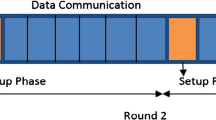Abstract
Wireless Sensor Networks (WSNs) are resource constrained networks with sensors not only gathering data from surroundings but also acting as a relay for forwarding the data received from the previous layers. This gradually increases the data load on the subsequent nodes as the data progresses towards the sink (Base Station) and results in what is called as “energy hole” problem; where a sensor node is completely drained off and hence the network breakdown takes place. Several load balancing schemes have been proposed to increase the network lifetime. With this objective in mind, this paper presents a novel fuzzy logic based K-means clustering routing protocol \(\tt F_{K-{\text {means}}}RA\) that handles the rotation of cluster heads (CHs) using fuzzy logic with K-means clustering in a random environment. Simulation has been carried out against the well known low-energy adaptive clustering hierarchy (LEACH) protocol with metrics viz. alive nodes, dead nodes, average residual energy, throughput and its observed that results of FK−meansRA outperform the LEACH protocol.











Similar content being viewed by others
Data Availability
No dataset was used or generated in this model.
References
Raza, M., Aslam, N., Le-Minh, H., Hussain, S., Cao, Y., & Khan, N. M. (2017). A critical analysis of research potential, challenges, and future directives in industrial wireless sensor networks. IEEE Communications Surveys & Tutorials, 20(1), 39–95.
Devi, C., TV, P., & Madhavi, M., et al. (2018). “Iot based health care monitoring system using wireless sensor networks.” Indian Journal of Public Health Research & Development, 9(12).
Elappila, M., Chinara, S., & Parhi, D. R. (2018). Survivable path routing in wsn for IoT applications. Pervasive and Mobile Computing, 43, 49–63.
Xin, H., & Liu, X. (2017). “Energy-balanced transmission with accurate distances for strip-based wireless sensor networks”. IEEE Access, 5, 16193–16204.
Li, J., & Mohapatra, P. (2007). Analytical modeling and mitigation techniques for the energy hole problem in sensor networks. Pervasive and Mobile Computing, 3(3), 233–254.
Shokeen, A., & Kumar, N. (2018). Leach: Innovative technique for WSNs. Current Trends in Information Technology, 8(1), 11–15.
Dwivedi, A. K., & Sharma, A. K. (2021). “Ee-leach: Energy enhancement in leach using fuzzy logic for homogeneous WSN”. Wireless Personal Communications, 1–21.
Manap, Z., Ali, B. M., Ng, C. K., Noordin, N. K., & Sali, A. (2013). A review on hierarchical routing protocols for wireless sensor networks. Wireless Personal Communications, 72(2), 1077–1104.
Heinzelman, W. R., Chandrakasan, A., & Balakrishnan, H. (2000). “Energy-efficient communication protocol for wireless microsensor networks. In Proceedings of the 33rd annual Hawaii international conference on system sciences. IEEE (p. 10).
Mahmood, D., Javaid, N., Mahmood, S., Qureshi, S., Memon, A. M., & Zaman, T. (2013). “Modleach: A variant of leach for WSNs”. In 2013 Eighth international conference on broadband and wireless computing, communication and applications. IEEE (pp. 158–163).
Manjeshwar, A., & Agrawal, D. P. (2001). “Teen: A routing protocol for enhanced efficiency in wireless sensor networks”. In IPDPS, 1, 189.
Manjeshwar, A., & Agrawal, D. P. (2002). “Apteen: A hybrid protocol for efficient routing and comprehensive information retrieval in wireless sensor networks”. In Parallel and distributed processing symposium, international, vol. 3. Citeseer (pp. 0195b–0195b).
Liu, X., & Zhang, P. (2017). Data drainage: A novel load balancing strategy for wireless sensor networks. IEEE Communications Letters, 22(1), 125–128.
Liu, X., Qiu, T., Zhou, X., Wang, T., Yang, L., & Chang, V. (2019). Latency-aware path planning for disconnected sensor networks with mobile sinks. IEEE Transactions on Industrial Informatics, 16(1), 350–361.
Kim, J.-M., Park, S.-H., Han, Y.-J., & Chung, T.-M. (2008). “Chef: Cluster head election mechanism using fuzzy logic in wireless sensor networks. In 2008 10th international conference on advanced communication technology, vol. 1. IEEE (pp. 654–659).
Bellavista, P., Cardone, G., Corradi, A., & Foschini, L. (2013). Convergence of MANET and WSN in IoT urban scenarios. IEEE Sensors Journal, 13(10), 3558–3567.
Funding
No funding.
Author information
Authors and Affiliations
Corresponding author
Ethics declarations
Conflict of interest
The authors declare that they have no potential conflict of interest.
Human and Animal Rights
Humans and animals are not involved in the work.
Additional information
Publisher's Note
Springer Nature remains neutral with regard to jurisdictional claims in published maps and institutional affiliations.
Rights and permissions
Springer Nature or its licensor (e.g. a society or other partner) holds exclusive rights to this article under a publishing agreement with the author(s) or other rightsholder(s); author self-archiving of the accepted manuscript version of this article is solely governed by the terms of such publishing agreement and applicable law.
About this article
Cite this article
Shah, I.A., Ahmed, M. \(\tt F_{K-means}RA\): Fuzzy K-Means Clustering Routing Algorithm for Load Balancing in Wireless Sensor Networks. Wireless Pers Commun 130, 1071–1083 (2023). https://doi.org/10.1007/s11277-023-10320-8
Accepted:
Published:
Issue Date:
DOI: https://doi.org/10.1007/s11277-023-10320-8




